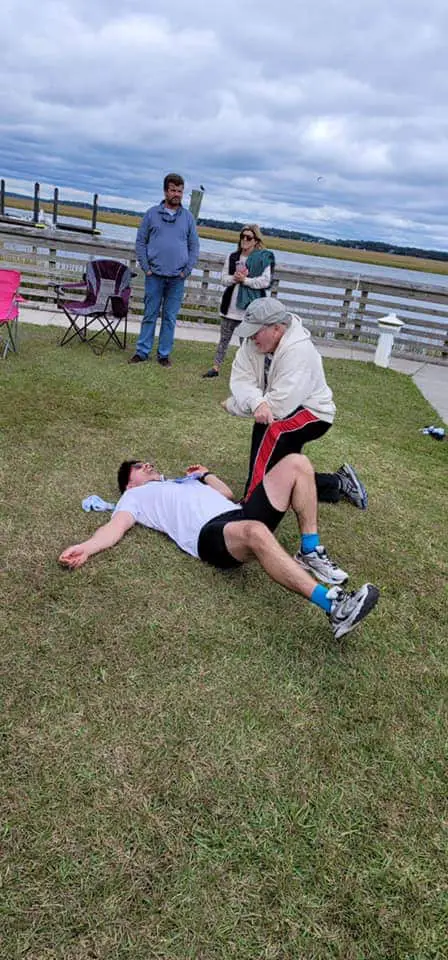


If you love exercise, enjoy competition (and even crave a little bit of pain), try out the Ironman 70.3: a long-distance swim, bike and run triathlon!

Andy Herrick: Jack-of-all-adventurer. Can be found scaling 5.10 crags, kayaking Class 3+ whitewater, trail running a half marathon, or bombing the local black diamond slopes depending on the season.
This year, my brother, Ben, invited me to do an Ironman 70.3 (although known as a half Ironman) triathlon.
Had I ever completed a triathlon of any length? No, I hadn’t. Could I swim more than 25 yards across a pool (with a strong tailwind)? No, I couldn’t. Did I let that stop me?
Read on to find out!
If you’re looking for a unique spin on outdoor adventure, consider a long-distance triathlon. Hosted by groups such as USA Triathlon and World Triathlon Corporation, triathlons are swim-bike-run events ranging from the Sprint distance to the full Ironman.
Here are the race distances for swim/bike/run in miles. Remember, a kilometer is about 0.62 miles!
Yes, you read that right! A Half Iron distance is a 1.2-mile swim, a 56-mile bike ride, and a 13.1-mile run.
Anything beyond these races is considered an “ultra” distance, suitable only for masochists and genetic freaks.
In my opinion, an international or Ironman 70.3 (also called Middle Distance Triathlon) is a great race distance for people looking for a new adventure. It’s long enough to be a worthy goal (people will say things like “wow!” and “I could never do that” and “Sh*t that sounds awful), but not long enough to be considered torture. It’s also a great excuse to hit your local hiking trails and cycling routes.
Unlike other adventures like mountaineering or SCUBA diving, running a triathlon isn’t a super technical sport (minus the swimming). If you’re a reasonably fit person without chronic leg injury, you can run an Ironman!
If you’re not sure where to start – well, I wasn’t either.
Actually, an Ironman 70.3 is a logistically complicated race. You need overnight security at transition zones, emergency bike repair crew, road closures, chip timing systems, etc.
Also, the average long-distance triathlete is upper middle-class with a fair bit of money on their hands. They’re willing to pay to play.
So you’ll find that most North American triathlons are hosted by one of two groups:
Now, you might be wondering if a triathlon really qualifies as an adventure. Isn’t it just a race?
Well, it’s not like summiting a 14er, I’ll give you that. But it’s actually a great opportunity to see the country! You can travel to the fall foliage of New England, the pine forests and pine trees of the coastal Southeast, or the red rock of the Southwest. You’ll need to train, both physically and mentally. And yes, you’ll need to bring your gear!
I finished my first Ironman 70.3 in 6:23. For reasons undisclosed, I could likely have finished faster, maybe around 6:05. So I promise you, this strategy works!
An Ironmnan 70.3 is a swim-bike-run triathlon with two transitions (T1 and T2) between the swim-bike and the bike-run.
I’ll dive more into the details throughout the article, but here’s a basic race-day game plan for finishing your first Half Ironman:
*Or use a snorkel (maybe) – more on this later!




A long-distance triathlon is not limited to any biome. However, you should carefully consider your chosen terrain.
If you’re not a strong swimmer, you’ll need to choose between:
Since you’re on this website, I’m assuming the idea of a pool sounds super boring to you. So let’s skip that idea.
I was anything but a good swimmer when I began training for the race. In the end, I swam 1.2 miles in the open ocean – and it was (kinda) easy!
So don’t let your preconceptions limit your options. While I would recommend an open water lake swim to a novice swimmer, you’ll find that most decent swimmers can swim in 1-2 ft surf conditions without much problem.
Some racecourses are flat; others are hilly. Some are just plain tortuous, designed to test your physical and mental fortitude.
If you enjoy mountain beauty, you’ll find plenty of races along the mid-Atlantic Blue Ridge mountains or the southern California Sierra Nevada or Coastal ranges.
If you enjoy the sultry south and salt spray, you can find triathlons along the Carolina Outer banks.
Some of the most beautiful and scenic North American triathlon racecourses include:
Shout out: I ran the Half Iron race in Edisto Island, South Carolina, surrounded by forests filled with gnarled live oaks draped in Spanish Moss and dotted with cabbage palms. It was lovely, and I highly recommend the course for anyone wanting to race flat and fast!
Of course, you can also go international, and enjoy everything from the Swedish Alps to the Hobbit Shire in New Zealand.
Spring and fall are ideal triathlon seasons!
In most of the country, summer is too hot for long-distance racing events. April – May and October – November are the best months. October may be the peak month – that’s when the Ironman 70.3 championship is held in St. George, Utah and the Ironman championship is held in Kailua-Kona, Hawai’i.
You can search the Ironman race calendar here or the USAT sanctioned events calendar here.
Unlike most other outdoor adventures, racing an Ironman 70.3 isn’t a self-supported event. So there’s very little risk of freezing to death while camping or fighting off a hyperphagic grizzly bear.
However, a few outdoor skills are in order:
As outdoor adventures go, running a long-distance triathlon is pretty safe. You’ll do a lot of training indoors, and during the race, safety watercraft accompany swimmers during the first leg. Plus, there are usually aid stations every mile during the final half marathon.
Unless you crash your bike (you were wearing a helmet, weren’t you? WEREN’T YOU?!!), you aren’t in danger of many accidental injuries.
Your bigger problem may be overtraining, stress and fatigue injuries, like IT band syndrome, shine splints or swimmer’s shoulder.
Thankfully, preventing overuse injuries isn’t too difficult.
Beyond overuse injuries, your other danger is chafing.
Don’t laugh – bad chafing can cause more bleeding and discomfort than a bike crash! Don’t run or cycle in untested gear. And get some Body Glide or petroleum jelly to protect your privates.
It’s hard to say what, if any, animals you’ll encounter while training or racing.
The ones to be concerned with are the ones in the water. If you’re swimming in the ocean, you need to be aware of jellyfish, which can pack a powerful sting (pour vinegar on the affected area).
On land, your greatest nemesis might be squirrels. Many a cyclist has skidded to a halt and flew over their handlebars trying to avoid a panicked squirrel.
P.S. If you’re really lucky, you might get to swim alongside dolphins during the race!



It’s an old adage, but true:
You don’t rise to the level of your expectations; you fall to the level of your training.
It almost goes without saying you need to be able to swim 1.2 miles, bike 56 miles, and run 13.1 miles in order to finish a Middle Distance triathlon.
But there’s more to it. You need to be able to do it relatively fast.
There are cut-off times in every race. While certain courses may vary, the standard cut-off times are :
Some races may also specify a cut-off time for the first half of the run.
That means, at a bare minimum, you need to do:
These times assume some length for transitions.
So quite frankly, you need to be in excellent shape. Running a half marathon at the end of the race is like running a full marathon when fresh.
I’m not here to give you a play-by-play training program. You can find them all over the web, like this one here.
Personally, I hate following step-by-step training programs. And unlike many triathletes, I didn’t have 15-20 hours a week to train. I had about 10, on average. Some weeks, I trained as little as 5-6 hours; others, I did as much as 13-15.
Here’s what you need to know in order to successfully complete a Half Iron race on just 10 hours (or less) of training per week:
You’ll get much more out of a 3 x 5k run at a 7:20 min/mile pace rather a single leisurely 15k. Use high-intensity and moderate-intensity exercises to get more out of shorter (50-90 minute) training sessions.
If you’re into the numbers, you should train based on your heart rate zone, which varies based on your maximum heart rate. And a good personal trainer will tell you the optimal schedule for varying your heart rate training to achieve maximum cardiovascular efficiency.
Or you can follow this simple list:
Your training should be split 60/30/10 between Levels 3/2/4. Don’t waste time in level 1.
You’ll spend almost half the race on a bike. Cycling, unlike running, requires a high level of muscular power output. Your training your muscles, not just your lungs.
So make the bike your priority. Build up those quads!
Secondly, do “brick” sessions when you bike and then run. It’ll teach you how to run when your legs feel like they’re filled with cement.
Unless you just love the pool, dont’ spend too much time in the water. A lot of training only results in a small performance in the water. Once you can swim the 1.2 miles in 45-55 minutes or so, move on.
There a bajillion ways to swim freestyle. Not all are well-suited for open water or triathlon racing.
If you’re a new simmer, like I was, then I found the following four YouTube channels to be INCREDIBLY helpful.
They’ll teach you all about how to streamline in the water, how to efficiently catch and pull, how to breathe in open water, and how to note waste energy while kicking.
Here’s what I’d add or highlight:
If you only have 10 hours a week, most of your time will be spent in 60-90 minute sessions, probably before or after work. Those sessions will be mostly made up of moderate- to high-intensity cycle workouts.
If you get bored, don’t feel bad about throwing in the occasional weightlifting session! Deadlifts, squats and lunges are great for building up leg strength.
If you don’t have time for a full workout, doing a 30-minute calisthenics workout – pushups, pullups, crunches, burpees, squats and lunges – is a great time-saver. Personally, I highly recommend doing sets of 50-100 bodyweight squats and lunges. It’ll quickly build up your muscular stamina.
But the truth is, you can’t avoid the long hauls forever. You need to subject your body to the occasional 4-hr bike ride or 2-hr run to adapt to the stress and the exhaustion. You have to teach your body how to burn fat, not just carbs.
As a rule, aim for one long-distance workout per training week, with two long-distance workouts per week during the last 3-4 weeks. Plan on tapering off those last 5-10 days to give your body a chance to recuperate.
There’s no reason to run a full 70.3-mile race before race day, but you should have finished 3-4 10+ mile runs and 45+ mile rides before the final event. You can’t train your body how to push hard for 5-8 hours on 90-minute training sessions, no matter how hard those sessions may be.

Get on that saddle! And try out real pavement, sometimes. You’ll need to strengthen your triceps and neck muscles to comfortably ride a road, touring or racing bike.

Nothing but experience prepares you for the feeling of swimming in deep, murky, cold, fish-infested waters. Get used to it, and soon you’ll love it!

Don’t just run on treadmills – run outside! It strengths your hamstrings far more than a treadmill, and varied terrain can also strength your ankles.
A triathlon is a gear-intensive event. It sounds simple, but you’ll spend several hundred (or thousand) dollars before it’s all over!
With that said, a word of caution: Don’t waste your time with super-expensive triathlon gear like tri suits, racing bikes, and their ilk. You can finish a race just fine without them. My rule of thumb: Don’t buy anything you’ll only use once.
Not gonna lie – a triathlon isn’t a super cheap event. It tatkes a lot of gear (see above), and you usually have to travel to an event, maybe rent an AirBnB, plus pay for race fees and swag, etc.
But you don’t have to spend $8,000 on a fancy-schmancy carbon fiber bike, either. You can get away with $500 total if you shop smart!
Price:
The big expense is definitely the bike.
If you’re looking to do a half ironman on the cheap, you can avoid most of the doodads and knickknacks.
Ebay is your best friend for used trisuits and wetsuits, which can be bought for 70+% off!
Good sources for used bikes include Craigslist, Facebook marketplace. You can get cheap new bikes from BikesDirect and other wholesale trailers. Avoid bikes from retailers like Walmart and Target – they are not much good.
However, I do recommend swapping out the stock tires for a decent pair of lightweight smooth racing tires over treaded cruiser tires. That alone can easily improve your time by 10-20 minutes!
Be aware that most anything labeled “triathlon” costs twice as much as the similar generic version.
Price:
You’ll need hammer gels for the race, plus a few to try out beforehand so you know they agree with you. Cost: $50 for a pack of 24.
Also recommend some Gatorade or other sports drink high in electrolytes rather than just water. Figure an extra $5-$10.
Plus, you’ll need the traditional pre-race night-before pasta dinner! Enjoy the experience: Eat out at a restaurant or at the race-sponsored event. Cost: $25.
Price:
Triathlon races are available all over the country. Transportation costs are up to you.
When at the race, you will need a vehicle to transport you and your gear. You may need to rent a vehicle if flying to the race destination.
Price:
Most triathlons are near urban centers or tourist destinations with plenty of housing and housing options, including hotels, hostels, resorts, private rentals, etc.
Lodging typically begins at $75 a night.
It may be difficult to find camping or other cheap accommodations while in the area.
Price:
You will need to pay a race entry fee. A common price is about $250-$350 for the race, per person. Some events are promoted as fundraisers for charitable organizations, in which case the entry fee can be twice as much!
If racing in USAT-sanctioned event, you will also need a USAT membership, which is $15 for a one-day license or $50 for a year.
Triathletes are gear freaks. They LIKE to buy gear. Don’t listen to the guy who says a race belt “is a necessity, people!” It’s not. WHen I raced, I beat athletes on $3,000 triathlon bikes. My bike cost $373 (it was a scratch n’ dent sale).
Run with a friend! I raced with my brother, and it made the training experience so. much. more enjoyable! Plus, there’s nothing like having someone else to cheer for at the finish line (or better yet, be cheered for).

Uhhh … why wouldn’t you? Pre- and post-race activities are 492,482,002 times better with friends and family! Plus, you need people cheering you along the way.
Minimum age is 18, although there are youth-only events. No maximum age – in fact, most participants are in their 40s and 50s, and I saw 70+ year olds running the race!
Race organizers typically locate bathrooms at the transition areas. Hopefully, Mother Nature doesn’t call while you’re on the bike.
See Notes on transportation in the Finances & Budget section.
See notes in the “Where and When to Go?” section.
Copyright 2021 – Adventure on the Cheap (SRVS)
